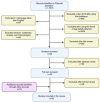Metabolomics in Childhood Asthma - a Promising Tool to Meet Various Clinical Needs
- PMID: 40341431
- PMCID: PMC12062110
- DOI: 10.1007/s11882-025-01198-6
Metabolomics in Childhood Asthma - a Promising Tool to Meet Various Clinical Needs
Abstract
Purpose of review: The aim of our review is to summarize the available literature where metabolomics was used in studies on childhood asthma, and to find metabolites that are diagnostic biomarker candidates in childhood asthma. Moreover, the review also describes studies related to metabo-endotypes and heterogeneity of childhood asthma, severity of the disease, and response to drug treatment.
Recent findings: Metabolomics has opened up new perspectives in childhood asthma investigation. Based on the available literature, we found nine metabolites that demonstrated the highest diagnostic potential for differentiation between children with asthma and healthy controls: adenine, adenosine, benzoic acid, hypoxanthine, p-cresol, taurocholate, threonine, tyrosine, and 1-methyl nicotinamide. Many of the identified metabolites are closely associated with inflammatory processes responsible for asthma. Metabolomic analysis also contributed to characterizing new asthma endotypes highlighting the heterogeneity of pediatric asthma. Metabolomics can bring about valuable insights, which, when integrated with other omic disciplines, can facilitate the diagnosis and management of childhood asthma and the search for new biomarkers of the disease. Improvements in the detection of asthma in preschool children, including asthma endotypes, will ease application of proper treatment and enable elimination of unnecessary test treatment of corticosteroids in young patients.
Keywords: Biomarkers; Metabo-endotypes; Metabolites; Pediatric asthma.
© 2025. The Author(s).
Conflict of interest statement
Declarations. Competing interests: The authors declare no competing interests. Human and Animal Rights and Informed Consent: This article does not contain any studies with human or animal subjects performed by any of the authors.
Figures



Similar articles
-
Metabo-Endotypes of Asthma Reveal Differences in Lung Function: Discovery and Validation in Two TOPMed Cohorts.Am J Respir Crit Care Med. 2022 Feb 1;205(3):288-299. doi: 10.1164/rccm.202105-1268OC. Am J Respir Crit Care Med. 2022. PMID: 34767496 Free PMC article.
-
A review of metabolomics approaches and their application in identifying causal pathways of childhood asthma.J Allergy Clin Immunol. 2018 Apr;141(4):1191-1201. doi: 10.1016/j.jaci.2017.04.021. Epub 2017 May 4. J Allergy Clin Immunol. 2018. PMID: 28479327 Free PMC article. Review.
-
Precision Medicine in Childhood Asthma: Omic Studies of Treatment Response.Int J Mol Sci. 2020 Apr 21;21(8):2908. doi: 10.3390/ijms21082908. Int J Mol Sci. 2020. PMID: 32326339 Free PMC article. Review.
-
Plasma metabolite profiles in children with current asthma.Clin Exp Allergy. 2018 Oct;48(10):1297-1304. doi: 10.1111/cea.13183. Epub 2018 Jul 3. Clin Exp Allergy. 2018. PMID: 29808611 Free PMC article.
-
Childhood asthma in the new omics era: challenges and perspectives.Curr Opin Allergy Clin Immunol. 2020 Apr;20(2):155-161. doi: 10.1097/ACI.0000000000000626. Curr Opin Allergy Clin Immunol. 2020. PMID: 31985545 Free PMC article. Review.
References
-
- NFZ o zdrowiu. Astma. Warszawa; 2020. Accessed 15 Feb 2024.
-
- GINA, Global Strategy for Asthma Management and Prevention. 2023. https://ginasthma.org/wp-content/uploads/2023/07/GINA-2023-Full-report-2.... Accessed 15 Feb 2024.
-
- The Global Asthma Report 2022. Int J Tuberc Lung Dis. 2022;26:1–104. https://www.ingentaconnect.com/content/10.5588/ijtld.22.101. Accessed 22 Feb 2024. - PubMed
Publication types
MeSH terms
Substances
Grants and funding
LinkOut - more resources
Full Text Sources
Medical
Research Materials

